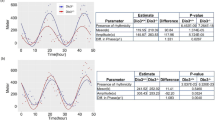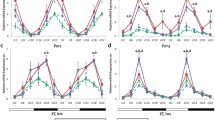Abstract
Biological clocks have evolved in all kinds of organisms in order to anticipate and adjust to the daily light–dark cycle. Within the last decade, the molecular machinery underlying the circadian system was unraveled. In the present study, the impact of the loss of the Per1 or Per2 genes, key components of the core clock oscillator, on body mass, food and water intake, glucose metabolism, and hypothalamic-pituitary-adrenal axis, was investigated in the Per1 Brd and Per2 Brd mouse models. The results reveal that the lack of Per1 but not Per2 has severe consequences for the regulation of these parameters. Specifically, in Per1 Brd animals, we found an impaired daily glucocorticoid rhythm, with markedly elevated levels during the day compared to control animals. In addition, Per1 Brd mice showed significant differences in body mass as well as food and water intake. Although the Per1 Brd are lighter than wildtype mice, food and water intake per gram body mass is elevated. In addition, the Per1 Brd mice exhibit an increased glucose metabolism after i.p. injection with glucose. In conclusion, our study presents first evidence for a link between an altered metabolism in Per1 and Per2 deficient mice, which in the case of the Per1 Brd animals might be due to an impaired corticosterone rhythm.



Similar content being viewed by others
Abbreviations
- SCN:
-
Suprachiasmatic nucleus
- HPA axis:
-
Hypothalamic-pituitary-adrenal axis
- Per :
-
Period
- CM:
-
Corticosterone metabolites
- LD:
-
Light/dark cycle
- WT:
-
Wildtype
- GC:
-
Glucocorticoid
- AUC:
-
Area under curve
References
Abarca C, Albrecht U, Spanagel R (2002) Cocaine sensitization and reward are under the influence of circadian genes and rhythm. Proc Natl Acad Sci USA 99:9026–9030
Albrecht U (2004) The mammalian circadian clock: a network of gene expression. Front Biosci 9:48–55
Albrecht U, Sun ZS, Eichele G, Lee CC (1997) A differential response of two putative mammalian circadian regulators, mper1 and mper2, to light. Cell 91:1055–1064
Bae K, Jin X, Maywood ES, Hastings MH, Reppert SM, Weaver DR (2001) Differential functions of mPer1, mPer2, and mPer3 in the SCN circadian clock. Neuron 30:525–536
Balsalobre A, Brown SA, Marcacci L, Tronche F, Kellendonk C, Reichardt HM, Schutz G, Schibler U (2000) Resetting of circadian time in peripheral tissues by glucocorticoid signaling. Science 289:2344–2347
Bartolomucci A, Pederzani T, Sacerdote P, Panerai AE, Parmigiani S, Palanza P (2004) Behavioral and physiological characterization of male mice under chronic psychosocial stress. PNEC 29:899
Cavigelli S, Monfort SL, Whitney TK, Mechref YS, Novotny M, McClintock MK (2005) Frequent serial fecal corticoid measures from rats reflect circadian and ovarian corticosterone rhythms. J Endocrinol 184:153–163
Cermakian N, Monaco L, Pando MP, Dierich A, Sassone-Corsi P (2001) Altered behavioral rhythms and clock gene expression in mice with a targeted mutation in the Period1 gene. Embo J 20:3967–3974
Cooney GJ, Lyons RJ, Crew AJ, Jensen TE, Molero JC, Mitchell CJ, Biden TJ, Ormandy CJ, James DE, Daly RJ (2004) Improved glucose homeostasis and enhanced insulin signalling in Grb14-deficient mice. EMBO J 23:582–593
Dallmann R (2004) Characterisation of Per mutant mice. PhD Thesis, University of Hannover, Hannover
Dernbach H (2003) Physiologische Aspekte der circadianen Rhythmik bei Kleinsäugern. Ph.D.-thesis, University of Hannover, Hannover, Germany
Devlin PF, Kay SA (2001) Circadian photoperception. Annu Rev Physiol 63:677–694
Eriksson E, Royo F, Lyberg K, Carlsson HE, Hau J (2004) Effect of metabolic cage housing on immunoglobulin A and corticosterone excretion in faeces and urine of young male rats. Exp Physiol 89:427–433
Kalsbeek A, Buijs RM (2002) Output pathways of the mammalian suprachiasmatic nucleus: coding circadian time by transmitter selection and specific targeting. Cell Tissue Res 309:109–118
Kalsbeek A, van Heerikhuize JJ, Wortel J, Buijs RM (1996) A diurnal rhythm of stimulatory input to the hypothalamo-pituitary-adrenal system as revealed by timed intrahypothalamic administration of the vasopressin V1 antagonist. J Neurosci 16:5555–5565
Karl T, Hoffmann T, Pabst R, von Horsten S (2003) Behavioral effects of neuropeptide Y in F344 rat substrains with a reduced dipeptidyl-peptidase IV activity. Pharmacol Biochem Behav 75:869–879
Kopp C, Albrecht U, Zheng B, Tobler I (2002) Homeostatic sleep regulation is preserved in mPer1 and mPer2 mutant mice. Eur J Neurosci 16:1099–1106
La Fleur SE, Kalsbeek A, Wortel J, Fekkes ML, Buijs RM (2001) A daily rhythm in glucose tolerance: a role for the suprachiasmatic nucleus. Diabetes 50:1237–1243
Le Minh N, Damiola F, Tronche F, Schutz G, Schibler U (2001) Glucocorticoid hormones inhibit food-induced phase-shifting of peripheral circadian oscillators. Embo J 20:7128–7136
Moore RY, Eichler VB (1972) Loss of a circadian adrenal corticosterone rhythm following suprachiasmatic lesions in the rat. Brain Res 42:201–206
Palme R, Rettenbacher S, Touma C, El-Bahr SM, Mostl E (2005) Stress hormones in mammals and birds: comparative aspects regarding metabolism, excretion, and noninvasive measurement in fecal samples. Ann N Y Acad Sci 1040:162–171
Penev PD, Kolker DE, Zee PC, Turek FW (1998) Chronic circadian desynchronization decreases the survival of animals with cardiomyopathic heart disease. Am J Physiol 275:H2334–H2337
Röhl M, Pasparakis M, Baudler S, Baumgartl J, Gautam D, Huth M, De Lorenzi R, Krone W, Rajewsky K, Bruning JC (2004) Conditional disruption of IkB kinase 2 fails to prevent obesity-induced insulin resistance. J Clin Invest 113:474–481
Rudic RD, McNamara P, Curtis AM, Boston RC, Panda S, Hogenesch JB, Fitzgerald GA (2004) BMAL1 and CLOCK, two essential components of the circadian clock, are involved in glucose homeostasis. PLoS Biol 2:e377
Saba GC, Saba P, Carnicelli A, Marescotti V (1963) Diurnal rhythm in the adrenal cortical secretion and in the rate of metabolism of corticosterone in the rat. Acta Endocrinol (Copenh) 44:409–412
Spanagel R, Pendyala G, Abarca C, Zghoul T, Sanchis-Segura C, Magnone MC, Lascorz J, Depner M, Holzberg D, Soyka M, Schreiber S, Matsuda F, Lathrop M, Schumann G, Albrecht U (2005) The clock gene Period2 influences the glutamatergic system and thereby modulates alcohol consumption. Nat Med 11:35–42
Spoelstra K, Albrecht U, van der Horst GT, Brauer V, Daan S (2004) Phase responses to light pulses in mice lacking functional per or cry genes. J Biol Rhythms 19:518–529
Steinlechner S, Jacobmeier B, Scherbarth F, Dernbach H, Kruse F, Albrecht U (2002) Robust circadian rhythmicity of Per1 and Per2 mutant mice in constant light, and dynamics of Per1 and Per2 gene expression under long and short photoperiods. J Biol Rhythms 17:202–209
Stephan FK, Zucker I (1972) Circadian rhythms in drinking behavior and locomotor activity of rats are eliminated by hypothalamic lesions. Proc Natl Acad Sci USA 69:1583–1586
Sun ZS, Albrecht U, Zhuchenko O, Bailey J, Eichele G, Lee CC (1997) RIGUI, a putative mammalian ortholog of the Drosophila period gene. Cell 90:1003–1011
Tei H, Okamura H, Shigeyoshi Y, Fukuhara C, Ozawa R, Hirose M, Sakaki Y (1997) Circadian oscillation of a mammalian homologue of the Drosophila period gene. Nature 389:512–516
Touma C, Palme R (2005) Measuring fecal glucocorticoid metabolites in mammals and birds: the importance of validation. Ann N Y Acad Sci 1046:54–74
Touma C, Sachser N, Mostl E, Palme R (2003) Effects of sex and time of day on metabolism and excretion of corticosterone in urine and feces of mice. Gen Comp Endocrinol 130:267–278
Touma C, Palme R, Sachser N (2004) Analyzing corticosterone metabolites in fecal samples of mice: a noninvasive technique to monitor stress hormones. Horm Behav 45:10–22
Turek FW, Joshu C, Kohsaka A, Lin E, Ivanova G, McDearmon E, Laposky A, Losee-Olson S, Easton A, Jensen DR, Eckel RH, Takahashi JS, Bass J (2005) Obesity and metabolic syndrome in circadian Clock mutant mice. Science 308 (5724):1043–1045
Verhagen LA, Pevet P, Saboureau M, Sicard B, Nesme B, Claustrat B, Buijs RM, Kalsbeek A (2004) Temporal organization of the 24-h corticosterone rhythm in the diurnal murid rodent Arvicanthis ansorgei Thomas 1910. Brain Res 995:197–204
Yamamoto H, Nagai K, Nakagawa H (1987) Role of SCN in daily rhythms of plasma glucose, FFA, insulin and glucagon. Chronobiol Int 4:483–491
Zheng B, Larkin DW, Albrecht U, Sun ZS, Sage M, Eichele G, Lee CC, Bradley A (1999) The mPer2 gene encodes a functional component of the mammalian circadian clock. Nature 400:169–173
Zheng B, Albrecht U, Kaasik K, Sage M, Lu W, Vaishnav S, Li Q, Sun ZS, Eichele G, Bradley A, Lee CC (2001) Nonredundant roles of the mPer1 and mPer2 genes in the mammalian circadian clock. Cell 105:683–694
Acknowledgements
This work has been supported by the German Research Foundation GRK 705 (RD). Prof. Heldmaier kindly provided the metabolic cages. We thank H. Oster and two anonymous reviewers for critical comments on previous versions of the manuscript. All procedures described regarding animal experimentation were in accordance with the animal protection act of the Federal Republic of Germany and the guidelines of the European Union (86/609/EEC). The experiments were approved by the district government of Hannover, Germany.
Author information
Authors and Affiliations
Corresponding author
Rights and permissions
About this article
Cite this article
Dallmann, R., Touma, C., Palme, R. et al. Impaired daily glucocorticoid rhythm in Per1 Brd mice. J Comp Physiol A 192, 769–775 (2006). https://doi.org/10.1007/s00359-006-0114-9
Received:
Revised:
Accepted:
Published:
Issue Date:
DOI: https://doi.org/10.1007/s00359-006-0114-9




